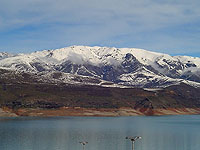 |
|
Uzbekistan - General Information |
|||
|
Surface waters The surface waters are unequally distributed in the country, due to climatic and geographic patterns. In contrast to entirely dry territories on the plains, the mountain areas usually have small rivers. Rivers. The country's rivers are fed by mountain snow. It is not a m ain source for mountain rivers though. During winter, underground waters usually fill the rivers. Two big rivers flow across the country: the Amu Darya and the Syr Darya. The middle and lower reaches of the Amu Darya River (about 1,415 km) and the middle reaches of the Syr Darya River (2,212 km) run along the territory of Uzbekistan. Small rivers in the country are: Naryn, Kara Daiya, Sokh, Zarafshon, Kashka Darya, Surkhan Darya, and Sherabad. Lakes. There are 80 lakes on the territory of Uzbekistan. All of them are small in size. The biggest lake is the Aral Sea , whose southern part belongs to Uzbekistan. Over the last decades the lake has considerably shrunk with water receding hundreds of kilometers from its shores. Numerous projects have been launched to tackle this problem. For instance, the International Fund for Saving the Aral Sea was established. Almost all of the lakes are in the mountains (at an altitude of 2,000-3,000 meters). Their surface is usually no more than 1 sq. km. The lakes on the plains are usually not very deep. Arnasoy and Sudoche lakes are rather big. Their size depends on the amount of water that comes from Chordara reservoir. There are artificial lakes - reservoirs that help to keep the seasonal balance of the water level in rivers. Big reservoirs are: Kayrakkum, Kattakurgan, Tuyabogiz, Chordara, and Southern Surkhan. In some areas the bigger river valleys have turned into swamplands. Sometimes it is difficult to discern these kinds of swamplands from lakes due to the fact that in summertime the water level falls in some lakes. Swamplands are rarely found in mountainous areas. There may be some but only small in size. The total length of the canals constructed for melioration and derivation purposes is more than 156,000 km. The main ones are: Amu-Bukhara, Big Namangan, Big Ferghana, North Ferghana, Eskiangor, and South Ferghana. With a view to meet its own needs in water, Uzbekistan exploits ground water resources as well. There are spring waters in mountain areas and artesian wells on plains. There are numerous mineral springs rich in hydrogen sulphide, iodine, radon and other minerals on the territory of Uzbekistan. The hydrogen sulphide springs in Ferghana and Surkhandarya basins are almost the same as Masesta spring waters in the Crimea. |

